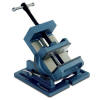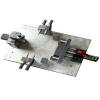Factors to consider to ensure proper clamping:
- The shape of the work.
- The type of material
- Size of the cut
- Specific machining operation
- Capacity of machine
- Production rate (ease of clamping
- Rigidity of workpiece
- Clamping device should be capable to be unaffected by the vibrations generated during an operation.
- The clamping force should not dent or damage the workpiece with excessive pressure.
A clamp is a fastening device used to hold or secure objects tightly together to prevent movement or separation through the application of inward pressure. There are many types of clamps available for many different purposes, such as:
Vice
Various machine vices are available and is suitable for regular shape work. Vice clamp directly to table of milling machine with t bolts. Care must be taken to ensure vice is set up square to table. Video
 |
 |
 |
 |
Jigs and Fixtures
Jigs and fixtures are production tools used to. accurately manufacture duplicate and interchangeable. parts. Jigs and fixtures are specially designed so that large. numbers of components can be machined or assembled.
 |
 |
 |
 |
Clamping tool set
There are a verity of machines claps that are available for milling and drilling. These claps can clamp regular and irregular shape workpieces with ease. Care must be taken to apply correct clamping techniques.
 |
 |
 |
 |
 |
 |
 |
 |